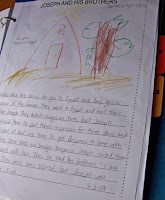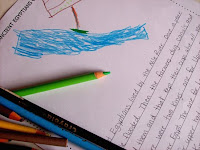
In short, our notebooking goes like this:
Dale and I read a lesson.
Dale tells me in his own words what the lesson was about.
I print a page with lines at the bottom and blank on top.
Dale colors a picture from the lesson at the top, and I write his narration at the bottom.
Or, the more detailed version:
We notebook for Bible, science, and history. For each of those subjects, a notebook page per lesson is about 90% of the sit-down paper-and-worksheet type work we do. With our schedule, this means we do 1-2 pages per day, and our time is not tied up with a lot of busy-work.
I often guide Dale through the process of him re-telling the lesson. This helps him jog his memory, and is teaching him composition skills simply by practicing it. While I may lead him in a certain direction, in the end, everything I write down is a direct quote straight from him. Sometimes we do this immediately after reading our selection, and sometimes it is later - anywhere from several minutes to the next day or two.
As far as the pages themselves, we have used a few I've gotten from around the Internet from sites like CurrClick and Notebookingpages.com, but mostly we use our own simple template from my word processor. It took just a few minutes to make, and is customizable - from the title we choose each day, to the font we use, to the border around the page. For now, I like using pages without added pictures and text, to really push Dale's creativity in his drawing.
I have had to let go of some perfectionist tendencies when it comes to what Dale chooses to draw on his page. As long as it is related to the lesson, I often bite my lip and let him draw whatever strikes him. Which is often NOT what I would have chosen. I do tend to lead him to try for accuracy and fact. I usually ask him to use colored pencils instead of crayons, which helps him work in more detailed and mature drawings.
Dale loves to flip back through his notebook to look at his pictures and read his words. This not only means frequent reviews of what we have learned, but also a growing love for learning the next lesson! When he is older, I will have him copy his narration in his own writing, and eventually he will write it himself without going over it orally with me first.
After several weeks of making 6-8 pages per week, I decided I didn't want to risk burning him out on a system I was seeing so many benefits in, so I backed off a bit and started offering different types of worksheets or activities. The best of these we put in our notebook as a record of what we have learned. Dale surprised me after a lesson one day, when he announced, "We need to do a notebook page on this!" Through that experience (and some like it since then), I have learned that Dale enjoys notebooking too, which is just the way I want it!

Also after having several weeks of bare-bones notebooking under our belt, I felt brave enough to branch out a little bit. We made a few lapbooks throughout Dale's preschool and kindergarten years and both enjoyed them. When we came upon a subject area recently that would be great for making a lapbook, I felt torn: I knew how time consuming a lapbook would be for us, but was still drawn to what a fun and hands-on project it could be for Dale.
So, we simply took the lapbook elements we wanted to use, and put them right into our notebook! It turned out to be much simpler to me than arranging them all into a folder, and really spiced up our notebook. We will definitely use this again as fitting subjects come up, but I am so happy not feeling the pressure to make each notebook page as involved as those.
Simple works. I dare say (because it is not overwhelming for either of us) that in some cases, simple works better.
Simple works. I dare say (because it is not overwhelming for either of us) that in some cases, simple works better.

Tips for Simple Notebooking:
- Only do notebook pages for a few subjects. 1-2 pages a day is plenty.
- Use simple supplies. A page you made or downloaded and pencils or crayons will get you a long way.
- Don't require lots of details for narration. A basic understanding is what you are looking for. A more detailed page can be made in addition to the broad one, if needed.
- File each page immediately. Occasional supplementary worksheets can add to your notebook, but don't clutter it up with too many - it could easily become distracting.
- Let your child have access to his notebook. He will love looking back through his work!

9 comments:
Awesome! I love notebooking! Christian hasn't done any yet this year. You've inspired me to get going!
I love this. We will have to incorporate some of this with our lessons!
I love your emphasis on simplicity. Because notebooking is so versatile, sometimes people get overwhelmed and think they can't do it. But you've kept the focus where it belongs! Thanks for sharing!
Great tips! We've incorporated notebooking (and lapbooking) into our homeschool in a very low key way. (I have to fight those perfectionist tendencies too!)
I found your cute blog through Jimmie's Collage. Love your post. We started out doing simpler notebooking when my son was in first grade, and I've tried to complicate things over the years since then. This year we are going back to a simpler form of notebooking and it is working better. Live and learn.
By the way, my son (now in 7th grade) still loves to go back and look at his history and science notebook he made in first grade!)
I found my way over here via Jimmie's blog. I love your tips for making simple, enjoyable notebooks that really focus on what's being learned.
I would love to encourage you to submit this post for the next Homeschool Showcase. I think it will encourage lots of moms to try something that may have previously seemed intimidating.
This is an inspiration to me! I've tried lapbooks with my 11 year old son and he really just thought it was okay. I think notebooking is more to his liking and you have shown me it doesn't have to be overwhelming. Thanks!
P.S. You should follow Kris' advice and submit this to the Homeschool Showcase!!!
Wow! simple is what i need. thank you for reiterating this point. i get so hung up on getting things just right and i just have to think "SIMPLE". i don't need to make it complicated.
I think i can actually think about getting a notebook started for my son now. He is always telling me what he remembers and i never right it down. He loves to draw pictures so you technique is wonderful1
Thanks
Jenn D.
This is such a great way to approach notebooking for younger students! Thanks for making it feel so do-able!
Post a Comment